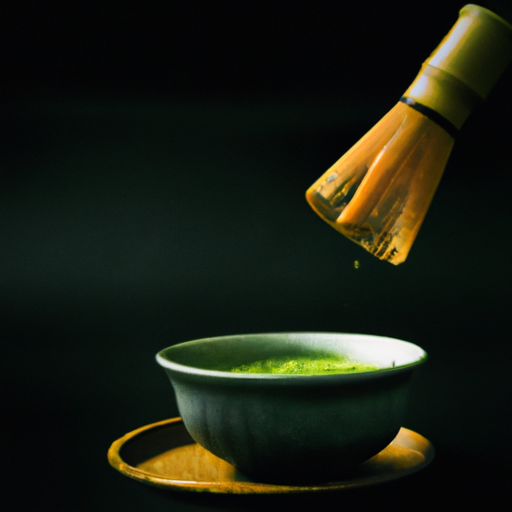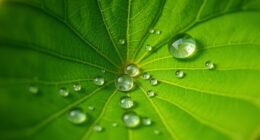Matcha tea serves as a soothing wind that sweeps through my senses, rejuvenating and invigorating me in the process. It has transformed into an essential part of my daily ritual, and rightly so.
Matcha tea is packed with antioxidants, vitamins, and minerals that boost my immune system, promote healthy digestion, and improve my cognitive function.
If you’re looking for a way to incorporate matcha tea into your routine, then you’re in the right place. In this article, I’ll be sharing my tips and tricks on how to make matcha tea from powder.
Whether you’re a seasoned tea drinker or a newbie to the world of matcha, this guide will help you make a perfect cup every time. So, grab your favorite mug and let’s get started.
Key Takeaways
- Choosing high-quality matcha powder is essential for a smooth and frothy texture.
- Use traditional tools like a bamboo whisk and prepare the tea with just below boiling water.
- Matcha tea offers numerous health benefits due to its high antioxidant content and can support weight loss and heart health.
- Proper storage of matcha powder in a cool and dry place can extend its shelf life up to a year.
Benefits of Matcha Tea
You’re in for a treat with matcha tea – not only does it have a delicious earthy flavor, but it’s packed with health benefits that will leave you feeling energized and refreshed.
Matcha tea is known for its powerful antioxidant properties, which help to prevent cell damage and reduce the risk of chronic diseases. In fact, matcha tea contains up to 137 times more antioxidants than regular green tea, making it one of the most potent sources of antioxidants available.
In addition to its antioxidant properties, matcha tea also contains a range of nutrients that can benefit your health. It’s rich in vitamins A, C, and E, as well as minerals such as potassium, calcium, and iron.
By drinking matcha tea regularly, you can help to boost your immune system, improve your heart health, and even support healthy weight loss. So, if you’re looking for a healthy and delicious beverage option, matcha tea is definitely worth considering.
Now, let’s move on to choosing the right matcha powder.
Choosing the Right Matcha Powder
When it comes to choosing the right matcha powder, there are three key points to consider: grades, flavor profiles, and quality indicators. As someone who loves matcha, I always make sure to do my research before purchasing a new brand or grade.
By understanding these factors, I can ensure I’m getting the best quality matcha powder for my needs and preferences.
Grades of matcha powder
The quality of matcha powder can greatly impact the taste and overall experience of your matcha tea, so it’s important to choose a grade that suits your preferences. Matcha powder grades can vary from culinary grade to ceremonial grade, and each has its own differences and uses.
Culinary grade matcha is usually cheaper and less vibrant in color, making it a good option for baking or adding to smoothies. Meanwhile, ceremonial grade matcha is the highest quality and is intended for traditional tea ceremonies. It has a bright green color, a smooth flavor, and a slightly sweet aftertaste.
To identify high quality matcha powder, look for a bright green color and a fine, powdery texture. Lower quality matcha may have a yellowish or brownish tint and a grainy texture. Additionally, ceremonial grade matcha is made from the youngest tea leaves, which are hand-picked and ground into a fine powder. The leaves are also shade-grown for several weeks before harvest, which increases the chlorophyll content and gives the matcha its bright green color.
When selecting your matcha powder, consider what flavor profile you prefer. Some matcha powders may have a more bitter taste, while others may have a sweeter or nuttier flavor. By understanding the different grades and quality indicators, you can choose a matcha powder that will create the perfect cup of matcha tea for you.
Flavor profiles
If you want to experience a taste explosion in your mouth, it’s essential to choose the right matcha grade that suits your preferences and flavor profile. Matcha powder comes in different grades, each with distinct flavor profiles.
For instance, sweet matcha powder has a milder flavor and tastes better when mixed with milk. On the other hand, savory matcha powder has a stronger taste and blends well with water.
When making matcha tea from powder, you also have the option of blending different grades to create a unique flavor profile. For example, mixing a little bit of sweet and savory matcha powder can create a balanced flavor that is neither too mild nor too strong.
Ultimately, the goal is to find the right blend that satisfies your taste buds. With so many options available, it’s easy to experiment and find the perfect combination that suits your preferences.
Now that you know about the different flavor profiles and blending options, it’s time to learn about quality indicators that will help you choose the best matcha powder for your needs.
Quality indicators
To truly experience the full potential of matcha, you’ll want to pay attention to quality indicators that highlight the nuances of each grade and ensure you’re getting the most flavor and health benefits out of your matcha.
Quality control is essential in the production and processing of matcha powder, as it can greatly impact the taste, color, and texture of the final product. Look for matcha that is bright green in color, indicating that it was grown in shade and has a high chlorophyll content. The texture should be fine and smooth, without any lumps or clumps.
Taste testing is also a crucial step in determining the quality of matcha, as it can reveal the flavor profile and overall freshness of the powder.
When preparing matcha, it’s important to use high-quality tools and ingredients to ensure the best results. A bamboo whisk, or chasen, is a traditional tool used to froth and mix the matcha powder and water together. It’s also recommended to use filtered water, as tap water can contain impurities that may affect the flavor of the tea.
By paying attention to quality indicators and using the right tools and ingredients, you can create a delicious and authentic cup of matcha tea.
Necessary Tools and Ingredients
Ready for some matcha tea? Before we begin, what do we need? A Beginner’s Guide to making matcha tea requires a few essential tools and ingredients.
Firstly, you need a bamboo whisk (chasen), a tea bowl (chawan), and a bamboo scoop (chashaku). These are traditional Japanese utensils that are designed to help you prepare the perfect cup of matcha tea. You can easily find them online or at your local tea store.
Secondly, you need high-quality matcha powder. You can choose from different grades of matcha powder, depending on your preference and budget. The ceremonial grade matcha powder is the highest quality and is ideal for special occasions. The culinary grade matcha powder is cheaper and is suitable for making matcha recipes for different occasions.
With these tools and ingredients, you’re ready to make some delicious matcha tea. Now, let’s move on to the next step of measuring the matcha powder.
Measuring the Matcha Powder
Now that we have our necessary tools and ingredients, let’s begin by measuring out the perfect amount of matcha for our tea.
Measuring matcha powder can be tricky, as it tends to clump together and can be difficult to get an accurate measurement. However, there are a few measuring techniques you can use to ensure that you’re using the right amount of matcha for your tea.
One popular method is to use a teaspoon to measure out the matcha powder. However, it’s important to note that not all teaspoons are created equal, so you may want to invest in a measuring spoon specifically for matcha.
Another tip for accuracy is to sift the matcha powder before measuring it, as this can help break up any clumps and ensure that you’re measuring an even amount.
With these measuring techniques and tips for accuracy, you can be sure that you’re using the perfect amount of matcha for your tea.
Now, let’s move on to preparing the water for our matcha tea.
Preparing the Water
First, you’ll need to heat up your water to just below boiling temperature. This is important because boiling water can actually burn the matcha powder, resulting in a bitter taste. To ensure that the water is at the right temperature, I like to use a kitchen thermometer. Ideally, the water should be between 160°F to 180°F.
Next, you’ll need to measure out the correct amount of water for the amount of matcha powder you’re using. A good rule of thumb is to use about 2 ounces of water for every 1/2 teaspoon of matcha powder. I find that this ratio gives the tea a nice balance of flavor and strength. Once you have your water measured out, you’re ready to move on to the next step of whisking the matcha.
Note: It’s important to pay attention to the water temperature and tea to water ratio when making matcha tea to ensure that you get the best possible taste.
Whisking the Matcha
Alright, now that we’ve got our water ready, let’s move on to the next step: whisking the matcha.
This is a crucial step in ensuring that your matcha tea turns out smooth and frothy. To achieve this, it’s important to use proper whisking technique and whisk for the right amount of time.
I’ll walk you through the steps and share some tips for getting the perfect matcha froth.
Proper whisking technique
To achieve a frothy and smooth texture in your matcha tea, you’ll want to whisk it vigorously using a back-and-forth motion like a ‘W’ shape. This is important because it not only provides a pleasant texture, but it also helps bring out the full flavor of the matcha.
As a matcha lover, I always start by sifting the matcha powder into my bowl to avoid clumps. Then, I add hot water and whisk vigorously until a frothy layer appears on top. It’s important to note that proper whisking technique is crucial in creating a delicious cup of matcha. Not only does it affect the texture and taste, but it also ensures that all the matcha powder is fully dissolved.
In the next section, we’ll talk about the ideal whisking time to achieve the perfect matcha tea.
Whisking time
Now that you know the proper whisking technique, you’ll want to focus on the whisking time to get the perfect cup of matcha every time.
The ideal whisking time for matcha tea is about 15-20 seconds, and the key is to whisk quickly and vigorously in a ‘W’or ‘M’motion. The faster you whisk, the more froth you’ll create, which is essential for the perfect cup of matcha.
If you find that your matcha is too thick or too thin, you can adjust the consistency by adding more or less water.
If you want a thicker, creamier texture, use less water and whisk for a little longer. If you prefer a lighter, smoother texture, add more water and whisk for a shorter time.
You can also experiment with different frothing techniques, such as swirling the whisk in a circular motion or tapping it against the bottom of the bowl.
Now that you’ve mastered the proper whisking technique and whisking time, it’s time to adjust the taste to your liking.
Adjusting the Taste
So now that I’ve whisked my matcha tea, it’s time to adjust the taste to my liking.
One way to do this is by adding sweeteners like honey, sugar, or agave syrup. I personally prefer to add a bit of honey to bring out the natural sweetness of the matcha.
Another option is to add milk or cream, which can help to mellow out the bitterness of the matcha and create a creamier texture.
Overall, adjusting the taste of matcha tea is all about finding the right balance of sweetness and creaminess to suit your personal preferences.
Adding sweeteners
Interestingly, matcha tea is naturally sweet, but for those who prefer a sweeter taste, there are many sweetener options available. Some people prefer to add honey or agave syrup to their matcha to enhance the flavor without overwhelming it. Others like to experiment with different flavor combinations by adding vanilla extract or even a touch of cinnamon.
When adding sweeteners to matcha tea, it’s important to use them in moderation. Too much sweetener can mask the delicate flavors of the tea and make it overly sweet. Once you’ve found the perfect balance, you can move on to the next step of adding milk or cream to your matcha for a creamier, richer flavor.
Adding milk or cream
For a creamy and indulgent sip, try adding a splash of milk or cream to your matcha. This can help mellow out the bitter taste of the tea and give it a smoother texture.
Here are some options to consider when adding milk or cream to your matcha:
-
Cow’s milk: This is the classic option and pairs well with matcha’s grassy flavor. Use whole milk for a richer taste or skim milk for a lighter option.
-
Almond milk: For a dairy-free alternative, almond milk is a great choice. It has a nutty flavor that complements matcha well.
-
Coconut milk: Another dairy-free option, coconut milk adds a creamy, tropical twist to matcha.
-
Oat milk: This trendy milk alternative has a mild, slightly sweet taste that won’t overpower the matcha.
If you’re looking for an alternative to milk, try adding a dollop of whipped cream or coconut cream to your matcha. These options will give your tea a decadent, dessert-like feel.
Once you’ve added your preferred milk or cream, it’s time to move on to serving your matcha tea.
Serving the Matcha Tea
Now that we’ve prepared our matcha tea, it’s time to serve it.
When it comes to serving matcha tea, there are two main styles: traditional Japanese tea ceremony and modern serving styles.
As someone who appreciates both the traditional and modern, I’m excited to explore both options and share my thoughts on each.
Traditional Japanese tea ceremony
Don’t miss out on the opportunity to experience the serene and meditative atmosphere of a traditional Japanese tea ceremony while enjoying your homemade matcha tea. The tea ceremony, also known as chanoyu or sado, is a cultural practice that originated in Japan in the 16th century. It has become a significant part of Japanese culture and is still practiced today.
Here are some important aspects of the traditional Japanese tea ceremony that you should know:
-
Origins and symbolism: The tea ceremony has deep roots in Japanese history and is closely tied to Zen Buddhism. It emphasizes simplicity, harmony, and respect for nature. The tea room is decorated with natural elements such as flowers and stones, and the ceremony itself is meant to be a calming and meditative experience.
-
Etiquette and rituals: The tea ceremony follows a strict set of rules and rituals that have been passed down through generations. Guests are expected to follow proper etiquette, such as bowing to the host and admiring the tea utensils. The ceremony also involves carefully choreographed movements, such as the way the tea bowl is held and passed between guests.
-
Tea preparation: The traditional Japanese tea ceremony involves preparing the matcha tea by whisking the powder with hot water until it becomes frothy. The tea is then served to guests in small bowls.
Immerse yourself in the rich cultural heritage of Japan by taking part in a traditional Japanese tea ceremony. After experiencing the calming and meditative atmosphere, you can explore modern serving styles that incorporate matcha tea into different types of beverages and desserts.
Modern serving styles
Indulging in the rich cultural heritage of Japan, you’ll find matcha-based beverages and desserts galore, proving that this vibrant, earthy flavor can be enjoyed in a wide range of creative and contemporary ways.
One of the most notable features of modern matcha serving styles is the contemporary presentation. Matcha lattes, for instance, have become a popular choice for coffee shop-goers and can be served in a variety of ways, from a classic cup to a trendy mason jar.
Matcha smoothie bowls, on the other hand, offer a unique twist on the traditional drink, served with a variety of toppings such as fresh fruit, granola, and nuts.
Serving suggestions can also vary depending on the occasion. Matcha shots, for example, can be served as a palate cleanser between courses at a fancy dinner party, while matcha cocktails can be a fun and refreshing addition to any happy hour. The possibilities are endless, and as the popularity of matcha continues to grow, so does the creativity of those who serve it.
Speaking of serving, now that we know how to make matcha tea from powder, let’s explore how to properly store it for optimal freshness.
Storing Matcha Powder
To keep your matcha powder fresh, make sure to store it in an airtight container in a cool, dry place. Storing matcha powder properly is important to ensure that it retains its flavor and color for as long as possible.
Here are some tips to help you store your matcha powder:
-
Keep it away from light: Matcha powder is very sensitive to light and can quickly lose its flavor and color when exposed to it. Store it in a dark place or in a container that blocks out light.
-
Avoid moisture: Moisture can make matcha powder clump and spoil quickly. Make sure to store it in a dry place, away from any sources of moisture.
-
Check the shelf life: Matcha powder can last up to a year if stored properly. Check the expiration date on the packaging and make sure to use it before it expires.
Now that you know how to store your matcha powder properly, let’s move on to some tips and tricks for making the perfect cup of matcha tea.
Tips and Tricks for Perfect Matcha Tea
Now that we know how to properly store matcha powder, let’s move on to the fun part – brewing a perfect cup of matcha tea!
As an AI language model, I don’t have any personal experience with drinking matcha tea, but I’ve learned a lot about the best brewing temperature and frothing techniques from my research.
First things first, the ideal brewing temperature for matcha tea is between 175-185°F (80-85°C). Boiling water can actually burn the tea leaves and result in a bitter taste. So, it’s important to let the water cool down for a few minutes after boiling before adding it to the matcha powder.
As for frothing, there are a few popular techniques like using a traditional bamboo whisk or an electric frother. Whichever method you choose, make sure to whisk the tea vigorously in a zig-zag motion to create a smooth and frothy texture.
With these tips in mind, you’re well on your way to enjoying a delicious cup of matcha tea!
Frequently Asked Questions
What is the difference between matcha powder and regular green tea?
Matcha is a type of green tea that is grown differently and undergoes a unique processing method. It has higher quality standards compared to regular green tea and is ground into a fine powder to be consumed as a whole leaf.
Can matcha tea be made with cold water instead of hot water?
Cold water matcha is possible, but hot water is recommended for a traditional taste. For a refreshing twist, try a Matcha latte recipe with cold milk.
How much caffeine is in a cup of matcha tea?
I love matcha tea for its unique taste and potential health benefits. A cup of matcha tea typically contains around 70mg of caffeine, which can help improve focus and metabolism.
Is it safe to consume matcha tea during pregnancy?
During pregnancy, it’s best to limit caffeine intake, including matcha tea. While matcha has many health benefits, it’s important to prioritize your baby’s safety. Let’s nurture our little ones like a garden, with care and caution.
Can matcha tea help with weight loss?
Matcha tea benefits weight loss due to its high concentration of antioxidants and metabolism-boosting properties. A simple recipe is to mix matcha powder with hot water and whisk until frothy, or try adding it to smoothies for an extra health boost.
Conclusion
Well, that’s it for my guide on how to make matcha tea from powder. I hope you found it helpful and informative!
As someone who loves matcha tea, I can honestly say that there’s nothing quite like a perfectly prepared cup of matcha. It’s not just a beverage, it’s an experience.
Making matcha tea is a lot like playing a musical instrument. It takes practice, patience, and a willingness to make mistakes and learn from them. But once you’ve mastered the technique, you’ll be able to create something truly beautiful and satisfying.
So go ahead, grab your matcha powder and bamboo whisk, and start your journey to becoming a matcha tea virtuoso!










